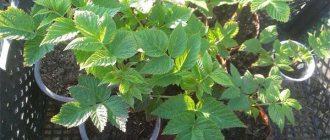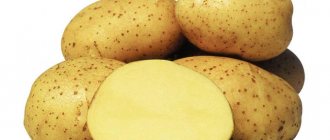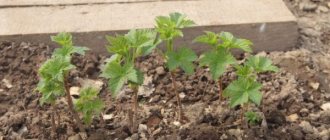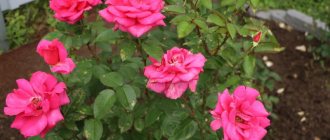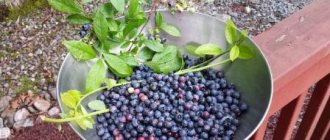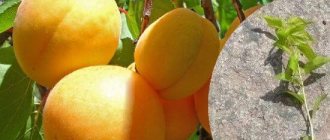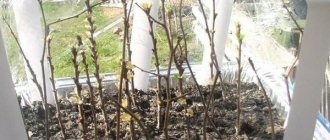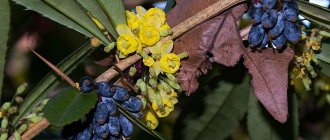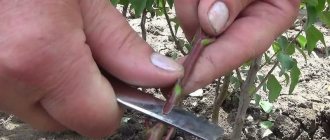Multi-tiered onions are also known as Viviparous, Horned, and Egyptian. It is believed that the plant originated from China. The peculiarity of this culture is its unusual appearance: not inflorescences are formed on the arrows, but aerial bulbs that hang above the ground. They form several successive tiers.
Multi-tiered onion is a perennial plant
Multi-tiered bow
Multi-tiered onions tolerate frost well
Plant characteristics
Multi-tiered onions are a hybrid crop. The plant does not produce seeds. It is propagated by bulbs formed on the shoots.
Multi-tiered onion is a perennial plant. Its main vegetative organ is the underground bulb. After planting in the soil, a large rosette with dark green leaves up to 40 cm high grows. In the first summer after planting, a peduncle is formed.
Small bulbs appear directly on the flowers, which are placed in 2-4 tiers. On the first of them up to 10 bulbs appear, on subsequent ones – fewer. If there is a fourth tier, then there are no more than 4 fruits the size of an oat grain.
The underground bulb is divided into several more daughter bulbs every year. After 3-4 years, a powerful nest and a bush of greenery is formed, which consists of 20-30 stems.
Distinctive features of culture:
- onion leaves are tubular, reaching 35 cm in height;
- during the growing season produces up to 3 shoots with aerial bulbs 1 m high;
- bulbs formed on the arrows do not require a rest period, so they can be grown at any time;
- aboveground small bulbs are yellow, purple or brown;
- the underground bulb ripens in September;
- the weight of one underground bulb is 40-50 g;
- onions produce a lot of juicy greens, which retain their taste until the first frost and do not become tough;
- the crop is frost-resistant and tolerates temperature conditions down to -50 degrees under a small layer of snow (up to 20 cm);
- the root system does not die off in winter;
- the crop grows in one place without losing the formation of abundant green mass for up to 6-7 years, subject to proper care;
- the plant is resistant to common pests that usually attack onions - thrips and onion flies;
- the crop has a developed root system that goes to a depth of 50 cm.
Under normal conditions, multi-tiered onions reproduce only by vegetative means, for which small onions formed on the arrows are used.
Common varieties
Popular crop varieties:
- Chelyabinsk. High-yielding, low-maintenance variety. During the season from 1st quarter. m you can collect up to 3.5 kg of fresh herbs and up to 1 kg of onion fruits (aerial bulbs). They are dense, crispy, and have a distinct pungent taste. The variety ripens in 20 days.
- Odessa Winter 12. Up to 30 aerial bulbs are formed on the peduncle. Green leaves reach 40 cm in length. From 1 sq. m harvest up to 2.4 kg of greens. The taste is spicy.
- Memory. Early variety. Onions grow quickly. For the season from 1st quarter. m manages to collect up to 3 kg of green leaves. One bulb produces an average of 4 green leaves.
- Likova. The advantage of this variety is the development of greenery even in insufficient illumination of the area. 2-8 aerial bulbs are formed in one inflorescence. Productivity – up to 3.6 kg per 1 sq. m.
- Gribovsky 38. The variety of multi-tiered onions is resistant to cold, which allows it to be grown in the lands of the Urals and Siberia. This crop is early ripening: the first harvest is harvested 3 weeks after the snow melts. Onion bushes are compact and dense.
Not too many varieties of multi-tiered onions are cultivated in Russia. Here this plant became widespread only at the end of the 20th century.
Reproduction methods
Longline crops can be propagated in two vegetative ways:
- Underground tubers . The fruits in the ground are dug up and divided into separate bulbs.
- Aerial bulbs . For this, fruits located on the second or third tier are used.
Important! To get good seeds from Egyptian onions, you can select two or three onion plants in the garden and do not cut off the feathers from them more than 2 times per season.
Growing conditions
Viviparous onions can be grown in both the northern and southern regions of the country. This can be done in open and closed ground.
Requirements for the site and soil:
- so that green shoots do not have to wait long, it is recommended to choose an area open to the sun, which is well warmed up by the sun's rays and protected from drafts;
- the site should be located on a hill so that moisture does not stagnate in the ground;
- multi-tiered onions love light soil, the composition of which allows air and moisture to pass unhindered;
- Heavy and acidic soil is not suitable for the crop: development in it will slow down, green feathers will grow weakly;
- if the soil is acidic, you need to add limestone, gypsum or wood ash;
- soil that is too heavy and has a high clay content can be improved by adding humus or sand;
- Before planting, you need to dig up the soil, remove weeds and apply fertilizer;
- Both organic fertilizers (for example, humus) and mineral fertilizers (superphosphate) are well suited for feeding.
It is better to plant multi-tiered onions in beds where potatoes, cabbage, zucchini, cucumbers or beets were previously grown.
The optimal time for planting onions is considered to be the second half of August and the first half of September. At this time, the crop will have time to take root and withstand the winter cold well, and in the spring it will begin to grow at a rapid pace.
With the onset of spring, fallen and rotten leaves need to be removed from the beds, as they act as a beneficial environment for the development of pathogenic microorganisms that can harm the vegetable crop.
The highest yield can be expected in the 2-3rd year of onion growth. At 5-6 years of development, the crop requires replanting or thinning. This is necessary because when a large number of root bulbs are formed, the underground bulbs become too small.
Landing
The material intended for planting must be carefully selected. To avoid fungal diseases, the bulbs should be placed in a weak solution of potassium permanganate and left for 3 minutes, then dried.
For planting in the ground, aerial (tiered) or underground bulbs are used. If the first ones are used, then it is better to take those that were placed on the first and second tiers.
The crop should be planted in furrows watered with water to a depth of 3-4 cm. The distance between each bulb should be 15-20 cm.
Planting material should be sorted by size in advance and each group should be planted in a separate row.
To obtain seed, the bulbs are planted in 1-2 rows at a distance of 10 cm. In the spring, the beds are thinned out, leaving only the strongest plants. You need to leave a distance of 20 cm between them.
After planting, you need to water the beds to speed up the process of root formation.
If onions are grown in boxes (in an apartment or greenhouse), then the heads should be planted tightly, one after another, and watered abundantly.
Reviews of multi-tiered onions
Two-tiered and multi-tiered onions are actively winning the hearts of amateur gardeners. Its fans note that it grows well in almost any climate.
Oksana, Kazakhstan: “Ask: how to grow a two-story onion? Yes, very simple! I recommend it to everyone, as caring for it is elementary. It overwinters at -40°C and feels great at +40°C in the summer.”
Elena, Russia : “I like the fact that you can eat any part. When there are a lot of onions, I pull them out by the roots. The head is very tender and tasty. I plant young onions from the second and third tier on greens in a box on the balcony.”
Ivan, Ukraine: “At first I was very surprised - what does planting onions in two tiers mean? But it turned out that such onions are productive and taste good, and do not cause much trouble. One bad thing is that it’s difficult to find planting material.”
Caring for outdoor crops
If you follow all the recommendations for growing the plant, you can get a rich harvest.
Watering
The culture needs moderate watering. If there is too much moisture, tender bulbs rot.
The beds are moistened as the top layer of soil dries. You don’t need a lot of liquid: pouring a large volume under the root can worsen the taste of the onion.
It is recommended to use warm water for irrigation. Recommended frequency is 2-3 times a week.
During the period of active growth, the beds need to be watered frequently and abundantly. To get juicy and fresh greens, the leaves of the crop need to be periodically sprayed with water.
Top dressing
In the spring, after the snow melts, mineral fertilizers are applied to the ground:
- potassium chloride;
- ammonium nitrate;
- superphosphate.
Proportions – 10 g of substance per 1 sq. m.
If there is a lack of nutrients, repeat the manipulation after 2-3 weeks.
In the second year of growth, the crop needs to be fed with complex mineral fertilizer, which consists of potassium, phosphorus and nitrogen substances (15 g, 40 g and 20 g, respectively).
After each cutting of green mass (about once every 3 weeks), it is recommended to feed the plants, alternating organic matter with complex mineral compounds.
Suitable organic fertilizers include ash (1.5 cups of wood ash per 10 liters of water), bird manure (mixed with water in a ratio of 1 to 1).
Weeding and loosening
Weeding allows you to get rid of weeds, which draw nutrients from the soil and become bait for some crop pests (for example, onion flies). Performed as the grass grows.
Loosening provides the required amount of oxygen to the underground bulbs. This event is held 2-3 times a season.
Garter
This manipulation is necessary because the arrows of a multi-tiered bow are unstable and prone to lodging due to the weight of the air bulbs. To prevent this, you need to install stakes in the area and stretch the twine between them so that it is above the middle of the arrows. Tie the upper tiers of the plant into bundles and secure them.
Pest and disease control
The crop is susceptible to diseases such as downy mildew and downy mildew. To prevent their development, you need to spray the plant with a weak solution of Bordeaux mixture. Repeat the procedure after 7 days. You can also use a solution of soda ash as a remedy by dissolving a tablespoon of the substance in a liter of water.
The main condition for preventing the appearance of insects and other pests of multi-tiered onions is the regular removal of feathers that dry out or begin to rot. The greatest danger to this crop is the onion fly and onion weevil.
Harvest and storage
The leaves are harvested early: the first feathers can be cut off already in April, when their length reaches 25 cm. They need to be cut at a level of 5-8 cm above the neck of the underground bulb.
The bulbs that have formed in tiers are harvested from late July to mid-August. By this time they acquire a purple tint interspersed with brown. To remove them, you need to carefully cut off the arrow with the bulbs 5 cm from the ground with a sharp knife.
Part of the harvest can be used for culinary purposes, another part can be used for storage and subsequent replanting in boxes in winter. Onions can also be planted in the soil in the spring to produce young, juicy greens.
Gardeners advise putting such onions for storage in pits or cellars. It is also stored in attics, in unheated rooms, in a layer of sand, at a temperature not lower than -2 degrees. The harvested crop can also be placed in the refrigerator or freezer, after drying and packing in paper bags. Bulbs that are not separated retain their external and taste qualities much longer.
In warm rooms, the collected bulbs begin to germinate and eventually die.
You can learn about the features of growing multi-tiered onions and their beneficial properties from the following video:
Multi-tiered onions have an unusual appearance and produce a lot of green above-ground mass - these are the distinctive features of the variety. To get a good harvest, you need to provide the crop with the necessary conditions for planting and growing.
1
0
Copy link
Beneficial features
This onion variety, like all other varieties, has beneficial properties. Used in traditional and folk medicine. It is used both for the treatment and prevention of diseases. Based on medical research, it can be understood that multi-layered onions contain a large amount of phytoncides, which in turn are successfully used as a means to relieve inflammation. Multi-level onions are also widely used in the treatment and prevention of hypertension.
It is also used for the prevention and treatment of the stomach and intestines.
In folk medicine, onions are used in the form of juices, compresses and as aromatherapy. When treating and preventing diseases of the upper respiratory tract, you need to cut the onion into several parts and breathe in the onion aroma several times a day. To relieve pain in the ears, you need to dilute the onion variety with water and drip into the ears. Also, with the help of an onion, you can heal a wound that does not heal for a long time. If a wasp bites you, you should immediately smear the bite site in half with a cut onion. This will relieve pain.
Using compresses made from onion pulp, you can also relieve pain from bruises and joint pain.
At the moment, the multi-tiered bow is little known. It is known only in certain regions of Russia. The bulbs of this variety contain a large number of biologically active substances beneficial to the body. And in this area it is not inferior to even the most popular onion varieties.
